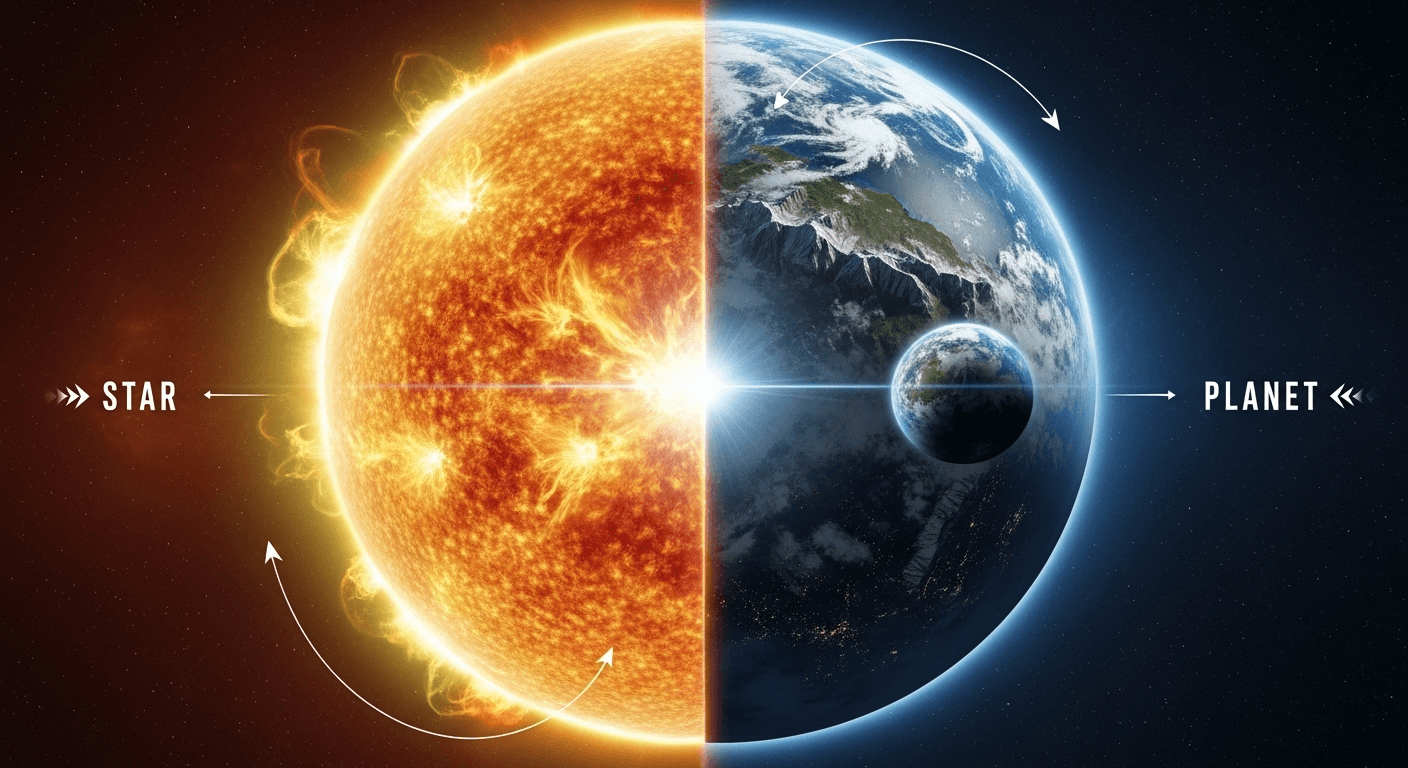When we gaze up at the night sky, we see a tapestry of countless shimmering lights. To the naked eye, they might all seem the same—distant, twinkling dots against a canvas of infinite black. Yet, these celestial bodies are fundamentally different. Some are gargantuan balls of fire, while others are cold, rocky, or gaseous worlds much like our own. Understanding these distinctions is the first step to comprehending our place in the cosmos. So, what is the difference between a star and a planet? While they both inhabit the same universe, they are as different as a bonfire and a stone, defined by their birth, composition, and their very reason for being. This article will explain in detail the fundamental characteristics that separate a star from a planet. The Fundamental Definition: The Engine of Light and Heat The single most important difference between a star and a planet lies in their ability to generate energy. One is a cosmic powerhouse, a self-sustaining nuclear reactor, while the other is a passive object that merely reflects the light of its parent. This core distinction is the foundation upon which all other differences are built. It dictates their temperature, their appearance, and their role within a celestial system. At its heart, a star is a luminous ball of plasma held together by its own immense gravity. The defining characteristic of a star is that it produces its own light and heat through a process called thermonuclear fusion. This process takes place in the star's core, where unimaginable pressure and temperatures, often exceeding 15 million degrees Celsius (27 million degrees Fahrenheit), force lighter atomic nuclei to fuse into heavier ones. For most of a star's life, this involves fusing hydrogen atoms into helium. This reaction releases an enormous amount of energy, which radiates outward, pushing against the inward pull of gravity and creating the light and heat that we observe. A planet, on the other hand, is fundamentally different because it lacks the mass to ignite and sustain thermonuclear fusion. A planet is a celestial body that orbits a star, is large enough to have been rounded by its own gravity, and has "cleared its neighborhood" of other smaller objects. It does not have an internal engine generating its own light. The light we see from planets like Venus, Mars, or Jupiter in our night sky is not their own; it is reflected sunlight. They are like cosmic mirrors, catching the brilliance of their local star and shining it back into space. While planets can have hot internal cores due to leftover heat from their formation and radioactive decay, this heat is insignificant compared to the ferocious energy output of a star. Formation and Origins: A Tale of Two Births The story of how stars and planets are born is dramatically different, though it often begins in the same place: a giant, cold cloud of gas and dust known as a nebula. These cosmic nurseries contain all the raw materials needed for creation. However, the path from a diffuse cloud to a star versus a planet diverges based on one critical factor: a "winner-takes-all" scenario driven by gravity. The Birth of a Star A star begins its life in the densest regions of a nebula. A trigger, such as a shockwave from a nearby supernova or a gravitational disturbance, causes a pocket of gas and dust to begin collapsing under its own gravity. As this cloud of material—mostly hydrogen—spirals inward, it starts to spin faster and heat up, forming a hot, dense core known as a protostar. This stage can last for hundreds of thousands of years as the protostar continues to accumulate more and more mass from the surrounding cloud. This accumulation of mass is the critical step. The protostar's gravity becomes increasingly powerful, pulling in more material and causing the pressure and temperature at its core to skyrocket. Eventually, a tipping point is reached. If the protostar has gathered enough mass (at least 8% of the Sun's mass), the core becomes so hot and dense that thermonuclear fusion ignites. This explosive start marks the true birth of a star. The outward pressure from the fusion energy balances the inward crush of gravity, creating a stable, long-lasting star that will shine for billions, or even trillions, of years. The Genesis of a Planet Planets, in contrast, are formed from the leftovers. After a star is born from the main gravitational collapse, a flat, spinning disc of gas and dust, known as a protoplanetary disk, remains in orbit around the newborn star. This disk contains all the material that wasn't consumed by the star itself. Within this disk, the process of planet formation, known as accretion, begins. It is a much less dramatic, bottom-up process compared to the top-down collapse that forms a star. Initially, tiny dust grains and ice particles begin to stick together due to electrostatic forces, like dust bunnies forming under a bed. Over millions of years, these clumps grow larger, forming pebble-sized objects, then boulder-sized objects, and eventually kilometer-wide bodies called planetesimals. These planetesimals have enough gravity to start attracting each other, leading to collisions and mergers. Through this chaotic process, they grow into larger protoplanets, and finally, after clearing out their orbital path, they become full-fledged planets. This is why planets are found orbiting stars—they are born from the star's own circumstellar nursery. Composition and Physical Characteristics The differences in formation directly influence what stars and planets are made of. One is an almost uniform ball of superheated gas, while the other can exhibit a stunning variety of surfaces, atmospheres, and internal structures. A Star's Fiery Makeup Stars are overwhelmingly simple in their composition, though their physical state is extreme. They are composed almost entirely of the two lightest elements: Hydrogen (~75%) Helium (~24%) The remaining 1-2% is made up of trace amounts of heavier elements, which astronomers collectively call "metals." Importantly, this material exists in a state of matter known as plasma. In a plasma, the intense





